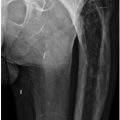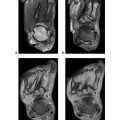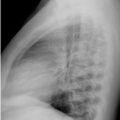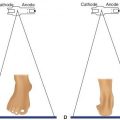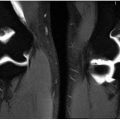A. Forestier disease
B. Plantar fasciopathy
C. Plantar fibromatosis
D. Morton neuroma
4 A 45-year-old male presents to his primary care provider with a palpable mass. The patient was informed the mass is benign. In regard to the imaged pathology, which feature, when present, would be concerning for malignancy?
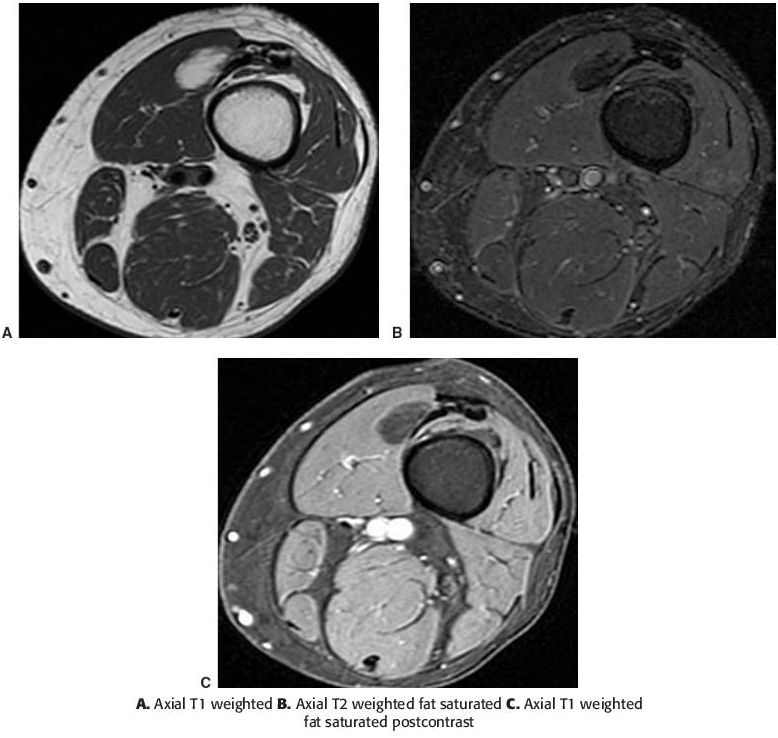
A. Thin septations
B. Nonadipose components
C. Intramuscular involvement
D. Thin rim enhancement
5 What is the most frequent donor site for cancellous bone grafting?
A. Rib
B. Iliac crest
C. Fibula
D. Distal radius
6 Which of the following would be a primary differential consideration for the disease process depicted by the MR images?
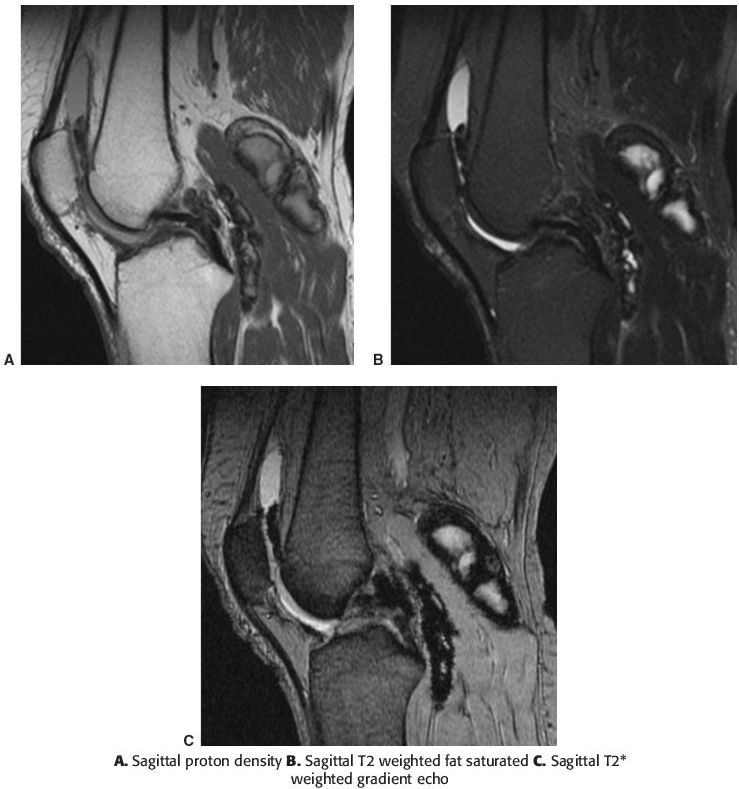
A. Synovial chondromatosis
B. Pigmented villonodular synovitis
C. Amyloid arthropathy
D. Synovial cell sarcoma
7 A 30-year-old male presents with a lesion in the proximal tibia. It is described as a well-defined, lytic lesion without a defined sclerotic margin, eccentric in location, and extending to the subarticular margin of the tibia. What is the most likely diagnosis?
A. Osteosarcoma
B. Giant cell tumor
C. Ewing sarcoma
D. Metastasis
8 A 17-year-old female presented with leg swelling. Based on the images, what is the most likely diagnosis?
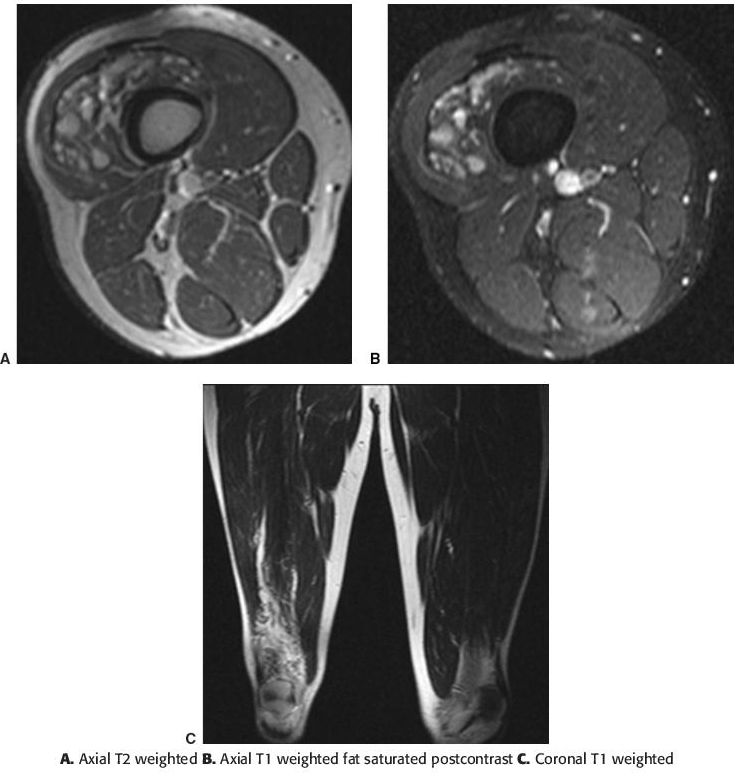
A. Intramuscular hemangioma
B. Klippel-Trenaunay-Weber syndrome
C. Arteriovascular malformation
D. Pseudoaneurysm
9 Which of the following is an appropriate indication for treatment of a nonossifying fibroma?
A. Pathologic fracture
B. Size >3 cm
C. Eccentric location
D. Lucent radiographic appearance
10 A 60-year-old female patient had the following bone scan and radiograph. What is the most likely diagnosis?

A. Paget disease
B. Multiple myeloma
C. Radiation osteitis
D. Osteoblastic metastases
11 A 6-year-old male presents to his pediatrician with a palpable lump involving his right lower leg. Based on the radiographs of his right tibia/fibula, which of the following is the most likely diagnosis?
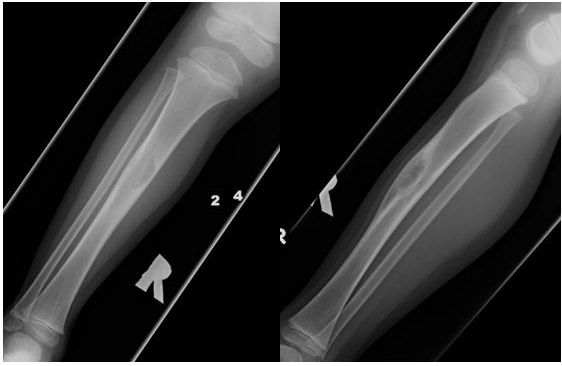
A. Aneurysmal bone cyst
B. Osteofibrous dysplasia
C. Lymphoma
D. Chondroblastoma
12 An 8-year-old girl presents with pain in the left hand fifth digit. There is no prior history of trauma. Which of the following is the most likely diagnosis?
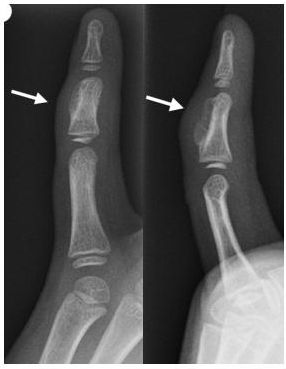
A. Myositis ossificans
B. Osteochondroma
C. Osteosarcoma
D. Bizarre parosteal osteochondromatous proliferation (BPOP)
13 Which of the following entities is seen in association with the tumor noted in the image below?

A. Ollier disease
B. Gardner syndrome
C. Peutz Jeghers syndrome
D. Maffucci syndrome
14 Regarding the disease process in the image below, which of the following statements best characterizes the potential for malignancy?
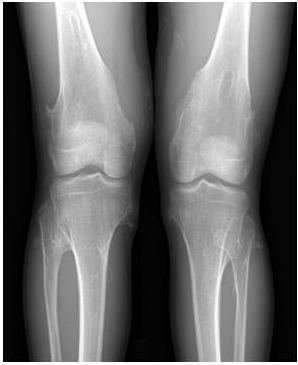
A. The patient is at a higher risk for transformation to osteosarcoma.
B. The patient is at a higher risk for osseous metastases to the lung.
C. The patient is at a higher risk for osseous skip lesions within the affected bone.
D. The patient is at a higher risk for transformation to chondrosarcoma.
15 A nerve sheath tumor is depicted in the images below. Which of the following statements about MR imaging signs of nerve sheath tumors is correct?
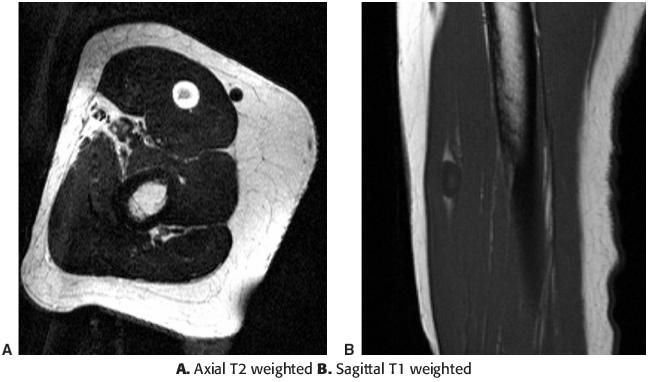
A. The fascicular sign is specific for a neurofibroma.
B. The target sign demonstrates increased signal centrally and more intermediate signal seen in the periphery of the lesion on T2-weighted sequences.
C. The split fat sign is specific for a neurofibroma.
D. An eccentrically positioned lesion in relation to the parent nerve suggests a schwannoma.
16 Which of the following findings would suggest malignant transformation of an osteochondroma to a chondrosarcoma?
A. Growth of a previously unchanged osteochondroma in a skeletally immature patient
B. Thickening of the cartilaginous cap to >1.0 cm
C. Development of a fluid signal intensity bursa overlying the lesion
D. Focal lucencies of destruction in the interior of a lesion
17 Which of the following statements about the MRI appearance of synovial chondromatosis is correct?
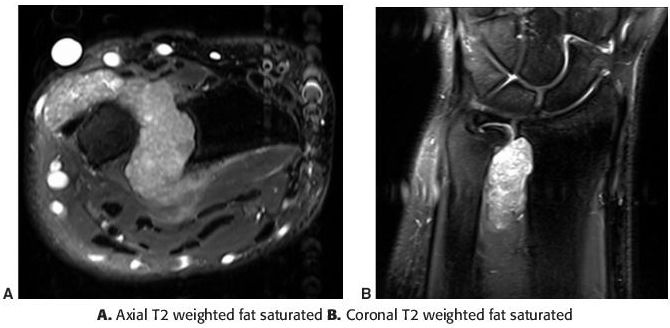
A. The adjacent bone typically does not have evident erosions.
B. It typically shows low MR signal and blooming artifact.
C. The chondromatosis bodies are commonly low on T1 and high on T2.
D. The involved synovium does not typically enhance.
18 Which of the following best characterizes the most common location for the lesion depicted in the image below?
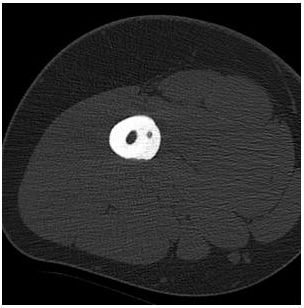
A. The most common long bone to be involved is the femur.
B. For intracapsular lesions, the most common location is the femoral condyle of the knee.
C. Thoracic spine location is more common than the cervical or lumbar spine.
D. An intramedullary location is more common than an intracortical location.
19 Which of the following is correct regarding the MRI appearance of synovial sarcoma?
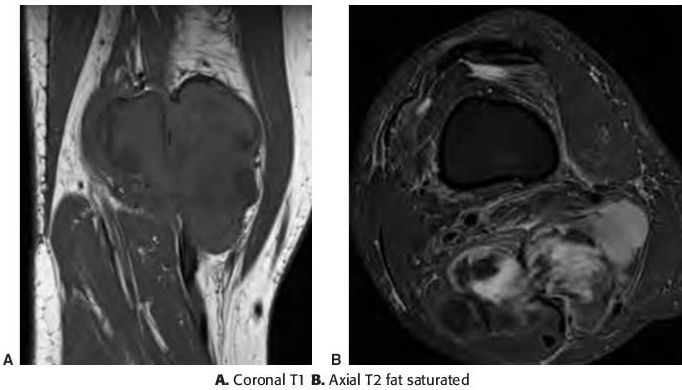
A. The T1 appearance is typically hyperintense to muscle.
B. The enhancement is typically homogeneous.
C. It can have foci of low signal resulting from areas of mineralization.
D. The T2 appearance is typically isointense to muscle.
20 Regarding the lesion in the image below, which of the following best describes the most common location?
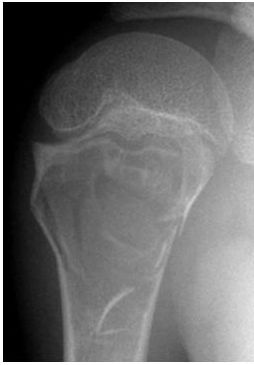
A. Intramedullary, central
B. Intracortical, central
C. Intramedullary, eccentric
D. Intracortical, eccentric
21 Which approach would be the most appropriate for percutaneous image-guided biopsy in this lesion?

A. A
B. B
C. C
D. D
22 Regarding the lesion in the image below, which of the following represents the best management?

A. The lesion is benign and should be not be biopsied.
B. The lesion is indeterminate and should be biopsied under image guidance.
C. The lesion may be malignant and should be surgically biopsied.
D. The lesion is malignant and should be surgically resected with a wide margin.
23 A patient presents with a history of painless swelling along the volar margin of the wrist. What is the most likely diagnosis?
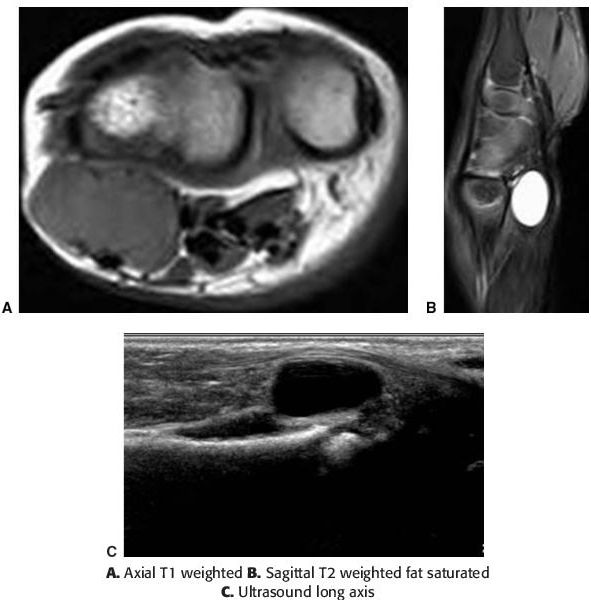
A. Ganglion
B. Giant cell tumor of tendon sheath
C. Synovial sarcoma
D. Nodular synovitis
24 Which of the following lesions most commonly occurs in the epiphysis of a long bone?
A. Unicameral bone cyst
B. Enchondroma
C. Chondroblastoma
D. Osteochondroma
25 Lymphangiomas are benign, primarily soft tissue tumors composed of lymphoid tissue lined by lymphatic endothelium. Where are they most commonly located?
A. Axilla
B. Abdomen
C. Neck
D. Lower extremities
26 A 77-year-old male complains of right hip pain 2 years following total hip replacement arthroplasty. What is the most likely diagnosis?

A. Multiple myeloma
B. Lytic form of Paget disease
C. Chondrosarcoma
D. Periprosthetic osteolysis
27a What type of matrix is present in the humeral lesion depicted in the radiograph?
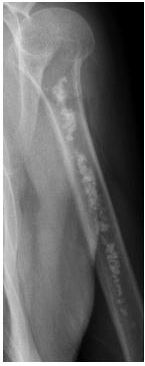
A. Chondroid
B. Fibrous
C. Lipoid
D. Osseous
27b Which of the following radiologic features best differentiates enchondroma from chondrosarcoma?
A. Endosteal scalloping
B. Chondroid matrix
C. Pathologic fracture
D. Soft tissue mass
28a A 19-year-old female presents with pain and the following radiographs. What is the most likely diagnosis of the lesion in the proximal phalanx?
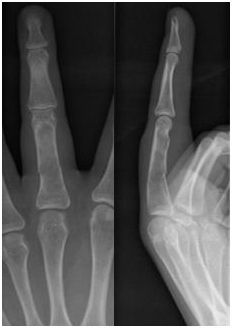
A. Nonossifying fibroma
B. Chondrosarcoma
C. Osteochondroma
D. Enchondroma
28b What is the best management option for this lesion?
A. Radiographic follow-up in 6 months
B. Chemotherapy
C. Surgical curettage and bone grafting
D. Digit amputation
29 A 42-year-old male presents with the following radiograph. Pathologic analysis described the lesion as a mixture of histologic elements. What is the most likely diagnosis?
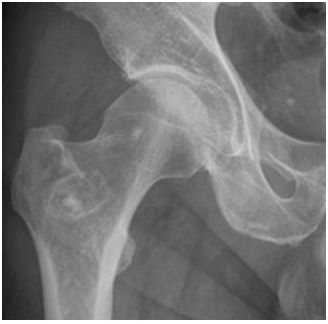
A. Lymphangioma
B. Hemangiopericytoma
C. Liposclerosing myxofibrous tumor
D. Langerhans cell histiocytosis
30a A 30-year-old female presents with the following radiograph and T1-weighted MR image of her ankle. What is the predominant composition of this lesion?
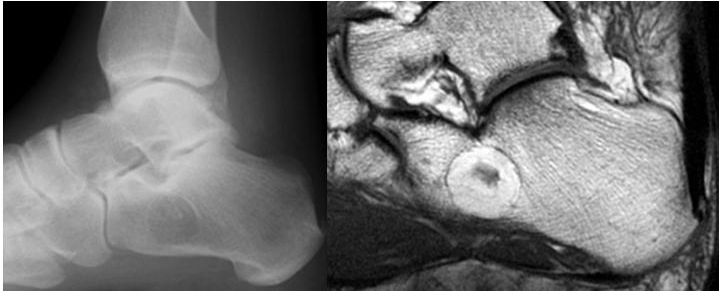
A. Fat
B. Neural
C. Cystic
D. Fibrous
30b The histologic grade of the lesion would be best described as which of the following?
A. Benign
B. Locally aggressive
C. Low-grade malignant
D. High-grade malignant
31a Which of the following is a typical MR imaging feature of an intraosseous hemangioma?
A. Coarsened trabeculae
B. Diffusely low signal intensity on T1-weighted images
C. Diffusely low signal intensity on T2-weighted images
D. No enhancement following contrast administration
31b Where are intraosseous hemangiomas most commonly located?
A. Femur
B. Rib
C. Vertebral body
D. Calcaneus
32a Sarcomatous degeneration occurs in approximately what percentage of patients with Paget disease with limited skeletal involvement?
A. 1%
B. 10% to 15%
C. 25% to 30%
D. 50%
32b What is the most common sarcoma associated with Paget degeneration?
A. Chondrosarcoma
B. Fibrosarcoma
C. Osteosarcoma
D. Malignant fibrous histiocytoma of the bone
33a A 61-year-old male presents with a 2-year history of right shoulder pain. You are presented a radiograph and sagittal T2-weighted fat saturated MR image for interpretation. What is the most likely diagnosis?
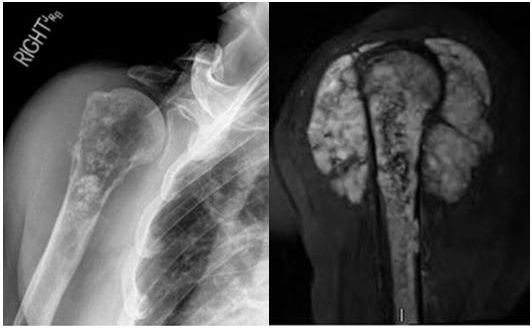
A. Osteosarcoma
B. Chondrosarcoma
C. Malignant fibrous histiocytoma (undifferentiated pleomorphic sarcoma)
D. Giant cell tumor
33b Where is the most common site of metastasis from primary chondrosarcoma?
A. Liver
B. Brain
C. Lung
D. Lymph nodes
33c Which of the following is the most common site of origin for primary chondrosarcoma?
A. Innominate bone
B. Ribs
C. Tibia
D. Spine
34 This 70-year-old male presented with an osseous and soft tissue mass in his left pelvis. He has a history of external beam pelvic radiation for prostate cancer. Osteosarcoma was diagnosed from the percutaneous biopsy. Which of the following dose options is most commonly associated with radiation-induced sarcoma?
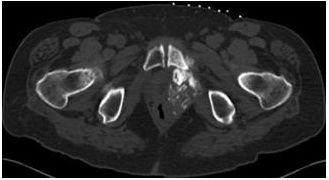
A. 100 cGy
B. 5,500 cGy
C. 7,500 cGy
D. 10,000 cGy
35 A 15-year-old female presents with left thigh pain. Based on the following radiograph and MR images, what is the most likely diagnosis?
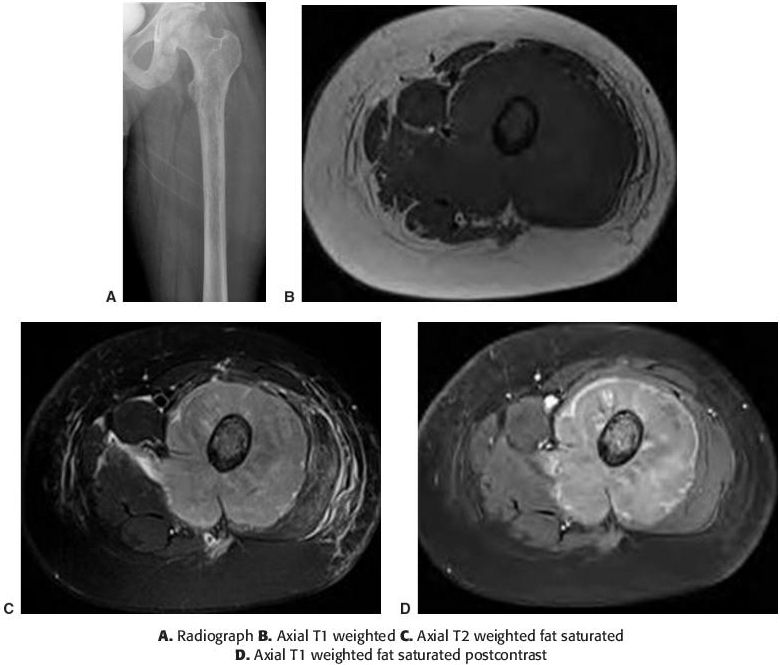
A. Chondrosarcoma
B. Ewing sarcoma
C. Parosteal osteosarcoma
D. Periosteal osteosarcoma
36a In Langerhans cell histiocytosis, osseous lesions are the most common disease manifestation. Which of the following is the most common location of extraosseous disease involvement?
A. Lungs
B. Skin
C. Lymph nodes
D. Salivary glands
36b Which of the following is the most common mean age range at diagnosis?
A. 0 to 10
B. 10 to 20
C. 20 to 30
D. 30 to 40
37a A 29-year-old male presents with the following images of his left forearm. What type of matrix is present in the osseous lesion in the proximal radius?
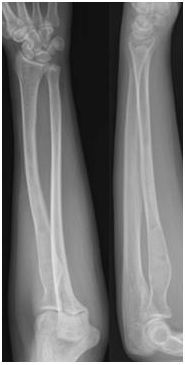
A. Chondroid
B. Fibrous
C. Lipoid
D. Osseous
37b McCune-Albright syndrome is defined as polyostotic fibrous dysplasia in conjunction with
A. pulmonary hypertension.
B. cardiomegaly.
C. endocrine abnormalities.
D. renal agenesis.
38 A 70-year-old patient presents to an orthopedic oncologist with the diagnosis of a bone tumor. Based on the following image, what is the diagnosis?
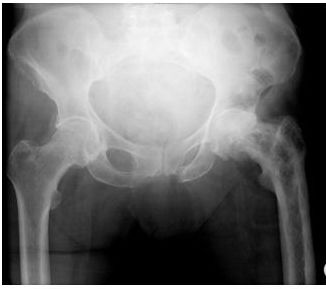
A. Osteosarcoma
B. Paget disease
C. Sclerotic bone metastases
D. Fibrous dysplasia
39a Myxomas are characterized pathologically as lesions with abundant myxoid stroma and bland spindle cells. These features result in which of the following MR imaging appearance?
A. Hyperintensity on T1 weighted
B. Hyperintensity on T2 weighted
C. Blooming on T2* gradient echo
D. No internal enhancement
39b Myxomas have a predication for which of the following tissues?
A. Bone
B. Fascia
C. Muscle
D. Fat
39c Mazabraud syndrome is characterized by myxomas and which of the following?
A. Fibrous dysplasia
B. Enchondromas
C. Neurofibromas
D. Soft tissue hemangiomas
40 An otherwise healthy patient presented with nonspecific shoulder complaints. This radiograph was obtained at the time of initial evaluation. A diagnosis of Gorham disease (Gorham-Stout syndrome) was entertained. Which of the following would best support the proposed diagnosis?
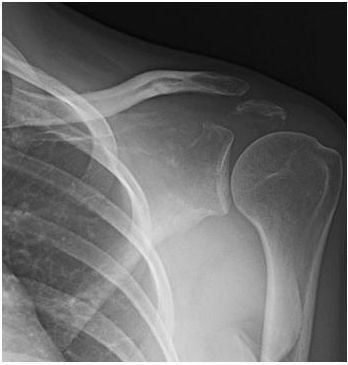
A. History of prior trauma
B. Pathologic fracture
C. Widespread destructive lesions
D. Splenic lesions
41a What would be the most accurate radiographic description of the metadiaphyseal tibial lesion?
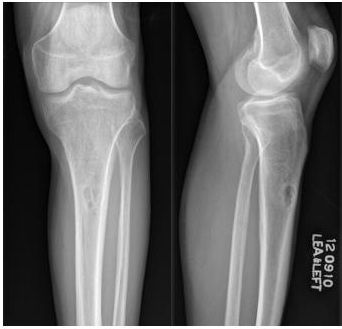
A. Septated, eccentric, geographic lucent lesion with no identifiable matrix
B. Expansile, bubbly lytic lesion with chondroid matrix
C. Well-defined, elongated lytic lesion with osseous matrix
D. Expansile, eccentric, geographic lucent lesion with osseous matrix
41b Which of the following would be the most likely diagnosis?
A. Aneurysmal bone cyst
B. Chondroblastoma
C. Chondromyxoid fibroma
D. Metastasis
E. Osteoblastoma
42 A 70-year-old man presents to his primary physician with the following radiograph and bone scan. Based on the images, what is the most likely diagnosis of the lesion in the left ilium adjacent to the sacroiliac joint?
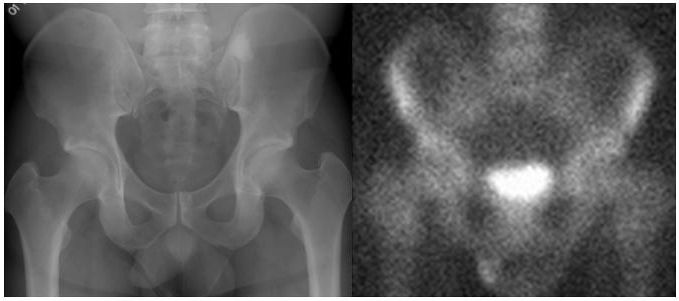
A. Untreated, sclerotic bone metastasis
B. Giant bone island
C. Osteoblastoma
D. Multiple myeloma
43 Given the imaging findings, which of the following choices should be included in the differential diagnosis?
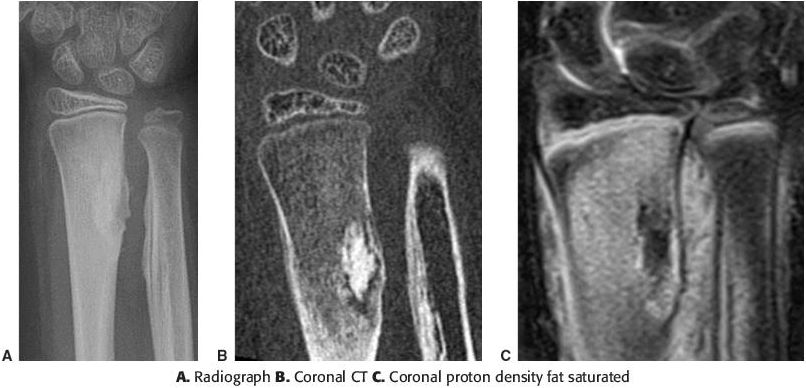
A. Osteoid osteoma
B. Chondroblastoma
C. Chondrosarcoma
D. Osteoblastoma
E. Metastasis
44a A patient with distal thumb tenderness undergoes MRI of the hand with axial T1-weighted, axial T1-weighted fat-saturated postcontrast, and coronal MR angiography images provided. Based on the imaging findings, what is the most likely diagnosis?
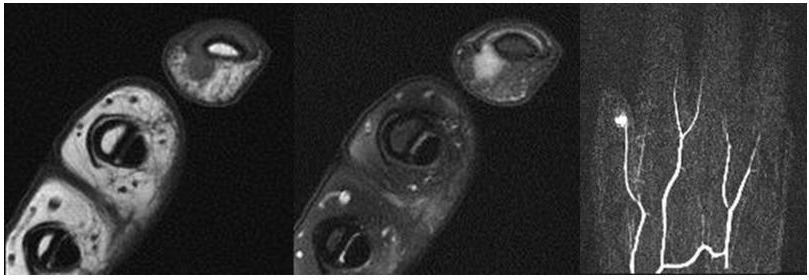
A. Melanoma
B. Glomus tumor
C. Giant cell tumor of the tendon sheath
D. Mucoid cyst
E. Epithelial inclusion cyst
44b What is the most common treatment of this lesion?
A. Embolization
B. Methotrexate
C. Radiation
D. Surgical excision
45 The multiple osseous lesions demonstrated in these radiographs best match with which of the following possibilities?
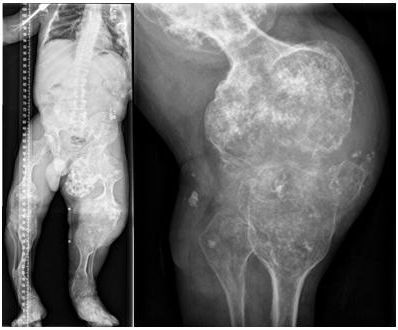
A. Multiple osteochondromas in the setting of multiple hereditary exostoses
B. Multiple nonossifying fibromas in the setting of Jaffe-Campanacci syndrome
C. Multiple enchondromas in the setting of Maffucci syndrome
D. Multiple osteochondromas and enchondromas in the setting of metachondromatosis
E. Multiple nonossifying fibromas in the setting of neurofibromatosis type 1
46 Lateral radiograph and axial and sagittal T1-weighted fat-saturated postcontrast images of the thumb are shown. The MRI demonstrates an avidly enhancing soft tissue mass with underlying bony erosions. Which of the following possible differential considerations is the most likely diagnosis given the radiographic and MRI findings?
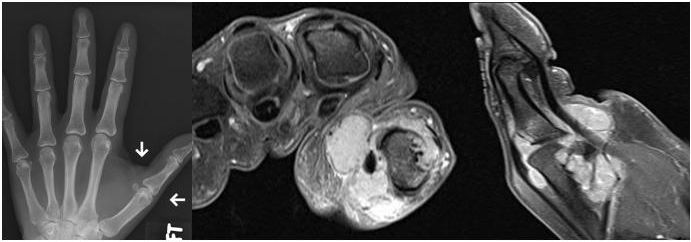
A. Ganglion cyst
B. Giant cell tumor of the tendon sheath
C. Hemangioma
D. Infection
47 AP standing radiograph, axial CT, and axial T2-weighted fat saturated MR images demonstrate a densely mineralized mass in a 64-year-old man. Based on the imaging findings, what is the most likely diagnosis?

A. Osteochondroma
B. Myositis ossificans
C. Parosteal osteosarcoma
D. Periosteal chondroma
E. Periosteal osteosarcoma
48 Differentiation between aneurysmal bone cyst and telangiectatic osteosarcoma on MRI can be difficult given both of these lesions demonstrate fluid-filled hemorrhagic spaces with characteristic fluid–fluid levels. In the case presented, which of the following imaging features suggests the correct diagnosis of telangiectatic osteosarcoma?
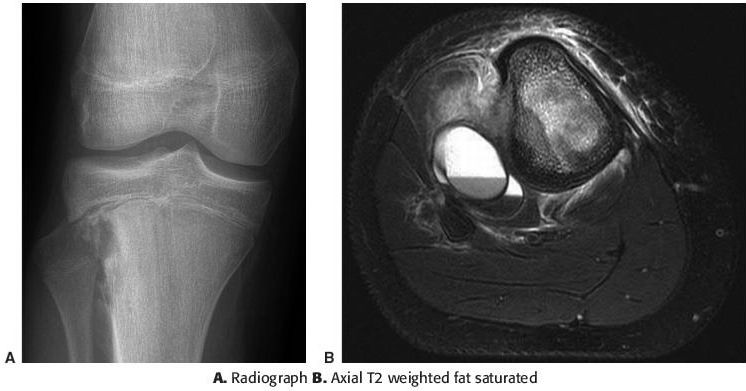
A. Thick nodular septations on MRI
B. Cortical destruction
C. Expansile remodeling
D. Eccentric location of lesion
49 In this patient presenting with nonspecific fullness along the anterior aspect of the ankle, the addition of what MR imaging sequence would be most helpful in confirming a suspected diagnosis of pigmented villonodular synovitis?
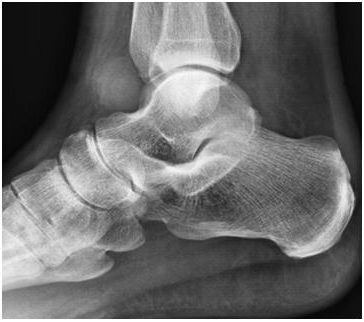
A. Proton density
B. T1 weighted, fat saturated
C. T2* gradient echo
D. Contrast enhanced T1 weighted, fat saturated
50 Pronounced bone marrow edema surrounding the lesion shown in the radiograph would be most characteristic of which of the following?

A. Chondroblastoma
B. Giant cell tumor
C. Enchondroma
D. Fibroxanthoma
51 This patient presented with a destructive lesion involving the right scapula. An MRI was obtained for further characterization. Based on the images presented, which of the following would be considered the most likely diagnosis?
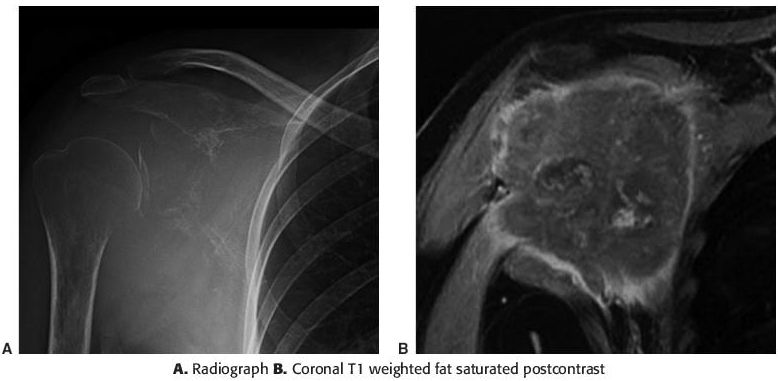
A. Angiosarcoma
B. Hemangioma
C. Plasmacytoma
D. Lymphoma
52 Regarding the images below, which of the following is the best diagnosis?
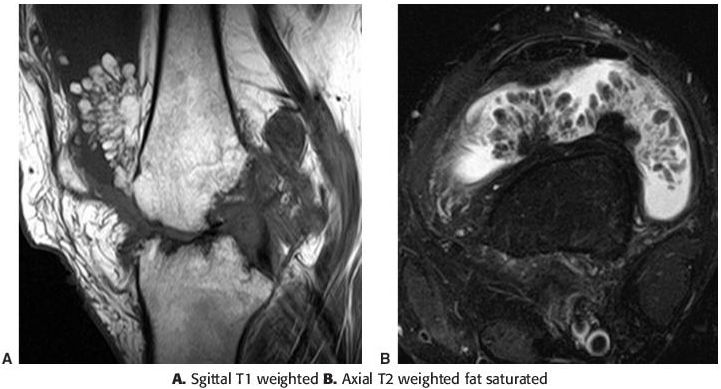
A. Pigmented villonodular synovitis (PVNS)
B. Synovial chondromatosis
C. Lipoma arborescens
D. Synovial hemangioma
53a Which of the following best characterizes the pattern of periosteal reaction demonstrated on the radiographs?
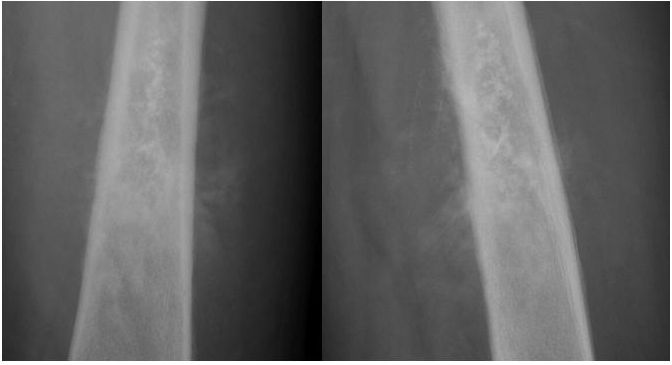
A. Septated
B. Laminated (onion skin)
C. Disorganized
D. Spiculated (sunburst)
53b This pattern of periosteal reaction is most commonly associated with which of the following?
A. Osteomyelitis
B. Eosinophilic granuloma
C. Conventional osteosarcoma
D. Chondroblastoma
54 Which of the following malignancies has the best long-term prognosis?
A. Periosteal osteosarcoma
B. High grade surface osteosarcoma
C. Parosteal osteosarcoma
D. Conventional osteosarcoma
E. Telangiectatic osteosarcoma
55 Which of the following has the highest prevalence of malignant transformation?
A. Enchondroma in Ollier disease or Maffucci syndrome
B. Osteochondroma in multiple hereditary exostoses
C. Nonossifying fibromas in Jaffe-Campanacci syndrome
D. Osteoma in Gardner syndrome
56 What radiographic finding would be diagnostic of a hemangioma in the hand?
A. Bony erosion
B. Soft tissue mass
C. Phleboliths
D. Cortical thickening
57 With regard to conventional osteosarcoma (high-grade intramedullary osteosarcoma), what percentage of cases have pulmonary metastases at the time of diagnosis?
A. 0% to 5%
B. 5% to 10%
C. 10% to 15%
D. 15% to 20%
58 Which of the following statements regarding the radiographic appearance of malignant fibrous histiocytoma (MFH) of the bone is most accurate?
A. Lacks periosteal reaction
B. Lacks a soft tissue mass
C. Presence of cortical expansion
D. Presence of a sclerotic margin
59a Regarding nodular fasciitis, where do lesions most frequently occur?
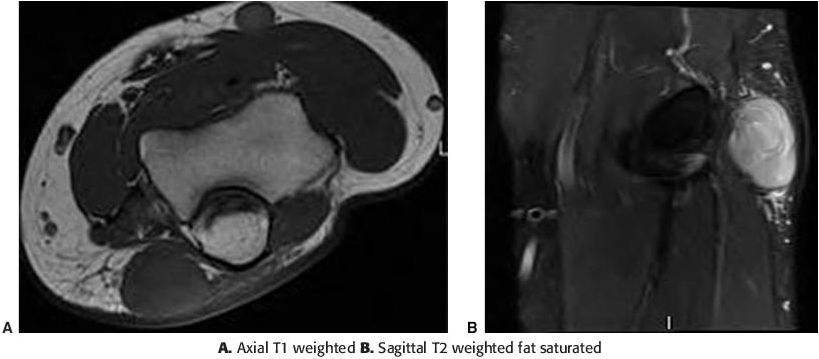
A. Trunk
B. Head and neck
C. Upper extremities
D. Lower extremities
59b The diagnosis of nodular fasciitis was made from a percutaneous biopsy. Of the following, which is the best treatment option?
A. Marginal surgical excision
B. Radical surgical excision
C. Chemotherapy
D. Radiation therapy
60 Regarding adamantinomas, which of the following is a characteristic imaging feature?
A. Expansile
B. Homogeneously sclerotic
C. Wide zone of transition
D. Sunburst periosteal reaction
61a A 60-year-old female presents with asymmetric enlargement of her left thigh. An MRI was performed. Based on the provided images, what is the most likely diagnosis?
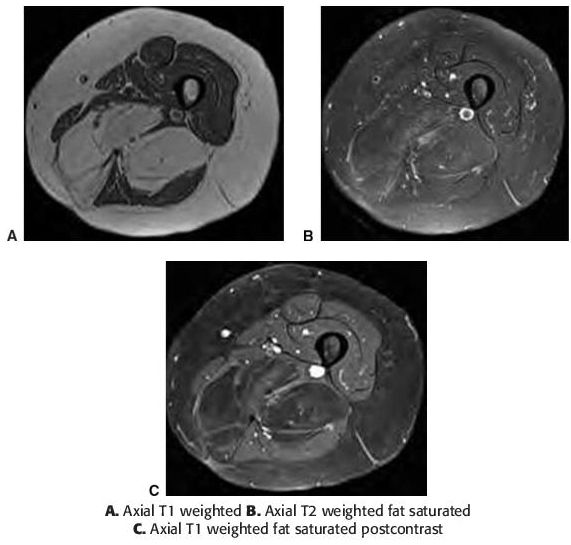
A. Well-differentiated liposarcoma (atypical lipomatous tumor)
B. Myxoid liposarcoma
C. Pleomorphic liposarcoma
D. Dedifferentiated liposarcoma
61b The lesion was surgically resected with clear margins. Which radiologic follow-up option is most appropriate?
A. MRI of the thigh to evaluate for local recurrence
B. MRI of the thigh to evaluate for local recurrence and CT chest to evaluate for metastatic disease
C. FDG-PET to evaluate for metastatic disease
D. MRI of the thigh to evaluate for local recurrence and nuclear medicine bone scan to evaluate for metastatic disease
62 A 70-year-old male presents with a soft tissue mass. On MRI, the lesion is a well-defined solid mass with smooth margins and homogeneous signal intensity. The lesion does not contain fat. What is the next best step in this patient’s care?
A. No further intervention is necessary as the lesion is benign given the above imaging description.
B. 6-month follow-up is recommended as the lesion is indeterminate.
C. Percutaneous or surgical biopsy is recommended since soft tissue sarcomas may have a bland appearance on MR.
D. Ultrasound to further attempt to characterize fat within the lesion.
63 A 25-year-old male presents with anterior knee pain. Two, consecutive T2-weighted fat-saturated and a T1-weighted fat-saturated postcontrast MR images are presented for interpretation. What is the most likely diagnosis?
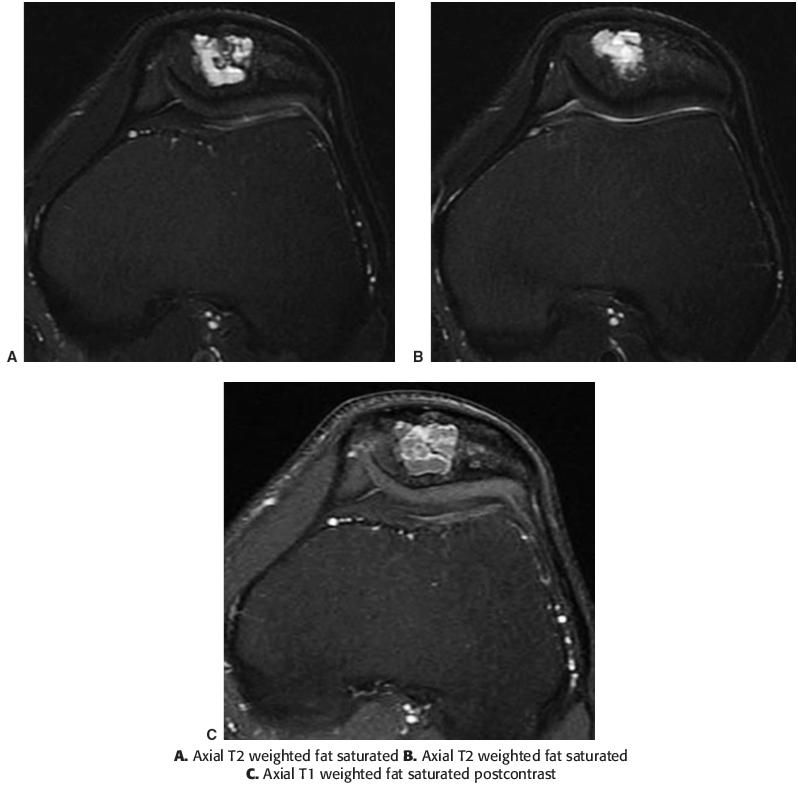
A. Giant cell tumor
B. Aneurysmal bone cyst
C. Osteomyelitis
D. Brown tumor in hyperparathyroidism
64 Which of the following most accurately describes the cellular origin of hemangioendotheliomas?
A. Tumor arising from smooth muscle cells of blood vessels
B. Tumor arising from collagen fibers in the tunica adventitia of blood vessels
C. Tumor of endothelial cells or their precursors
D. Tumor of abnormal proliferation of red blood cells
65 A 60-year-old male presents with the following radiographs. What is the most likely diagnosis?
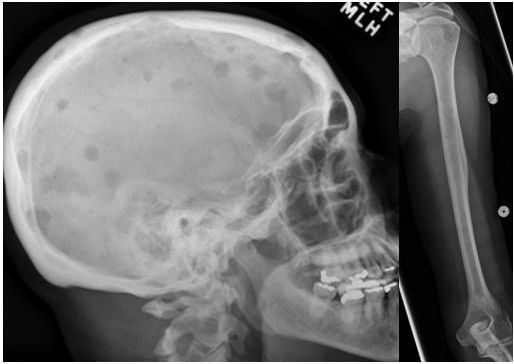
A. Primary osteoporosis
B. Lymphangioma
C. Prostate metastases
D. Multiple myeloma
66 An 18-year-old female presents with the following radiograph and MR images of her left humerus. What is the most likely diagnosis?
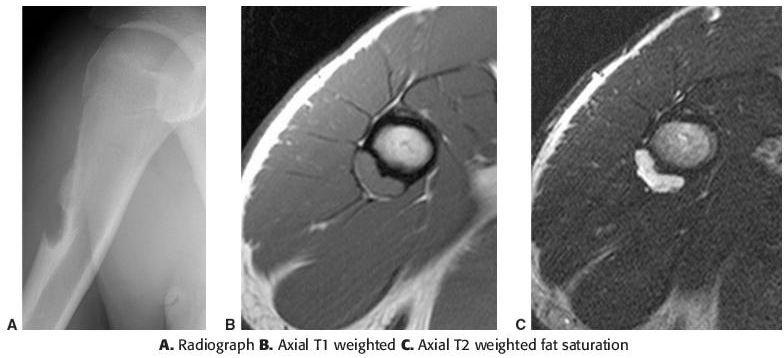
A. Myositis ossificans
B. Periosteal desmoid
C. Osteochondroma
D. Periosteal chondroma
67 Which of the following paraneoplastic syndromes is associated with hemangiopericytomas (solitary fibrous tumor)?
A. Hypoglycemia
B. Hyperglycemia
C. Hyperphosphatemia
D. Hypercalcemia
68 A 16-year-old male presents with a lesion in his proximal tibia. Which of the following is the recommended biopsy path?
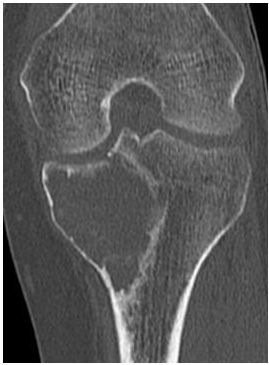
A. Anteromedial
B. Anterolateral
C. Posteromedial
D. Posterolateral
69 Periosteal and parosteal osteosarcomas are surface lesions. Which of the following imaging appearance is more characteristic of a periosteal osteosarcoma?
A. Mature bone extending from the center of the lesion to the periphery.
B. Bone marrow is nearly always involved.
C. “Sunburst” appearance due to calcified spicules of the bone perpendicular to the cortex.
D. Neoplastic cortical thickening rarely with an associated soft tissue mass.
70 A patient presents with a disseminated, hamartomatous disorder composed of hemangiomatous and lymphangiomatous lesions in the axial and appendicular skeletal and visceral organ involvement. Which of the following diagnoses is accurate?
A. Mastocytosis
B. Cystic angiomatosis
C. Langerhans cell histiocytosis
D. Multiple myeloma
71 Which of the following most accurately describes the margin of the lesion in the humerus?
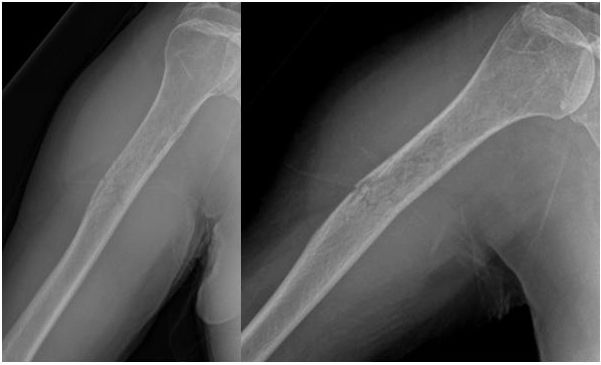
A. Geographic, well defined with no sclerotic margin
B. Nongeographic, well defined with no sclerotic margin
C. Geographic, ill defined
D. Nongeographic, permeative
72 A 70-year-old male presents with right wrist pain and the following radiograph. Assuming metastatic disease, which of the following is the most likely primary tumor?
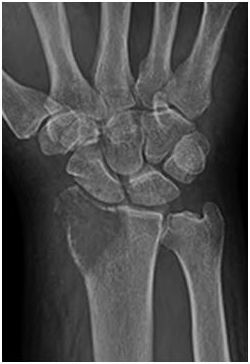
A. Renal cell carcinoma
B. Neuroblastoma
C. Prostate carcinoma
D. Papillary thyroid carcinoma
73 Regarding osseous lymphoma, which of the following imaging features is accurate?
A. Primarily occurs in the epiphysis of long bones
B. Primarily a sclerotic lesion with a dense tumor matrix.
C. Periosteal reaction is uncommon.
D. Often associated with a soft tissue mass.
74 A 25-year-old female presents with the history of a neck mass for 2 years. Which of the following is the most likely natural history of the tumor noted in the images below?
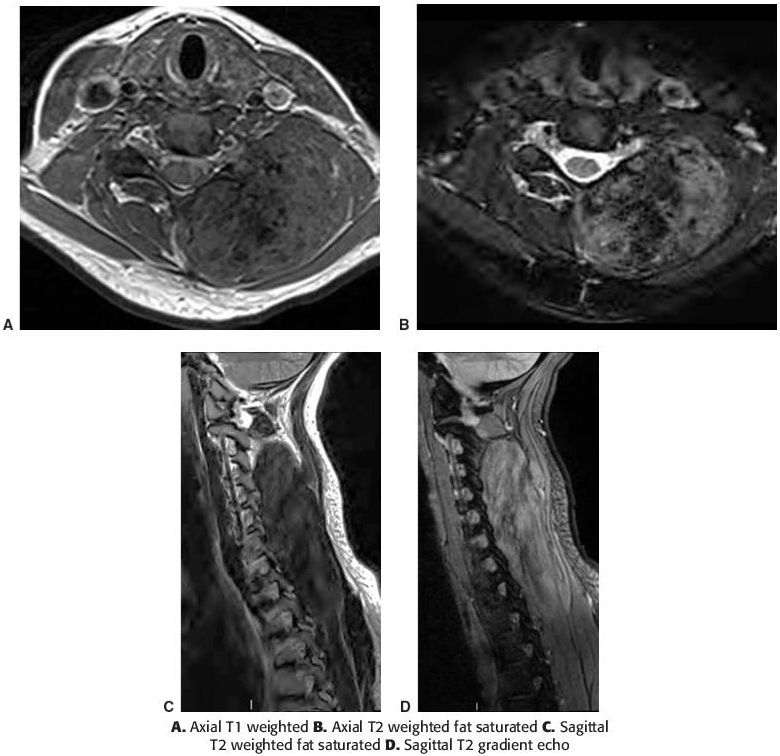
A. The lesion has stabilized in size since the patient is skeletally mature.
B. Regression over time with areas of dystrophic calcification and cyst formation
C. Invasion of the adjacent neural foramina
D. Metastatic disease to the lungs and liver
75 A 65-year-old female presents with the following soft tissue mass in her right thigh. Statistically, which of the following options represents the most likely diagnosis?
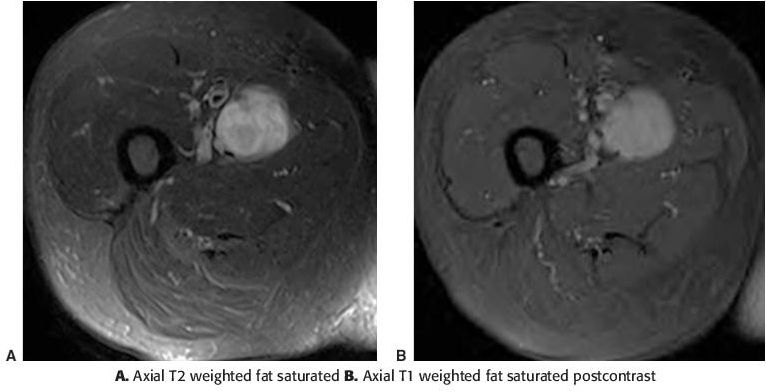
A. Pleomorphic liposarcoma
B. Leiomyosarcoma
C. Synovial sarcoma
D. Malignant fibrous histiocytoma (undifferentiated pleomorphic sarcoma)
ANSWERS AND EXPLANATIONS
1 Answer B. Ollier disease is a nonhereditary dysplasia characterized by the presence of multiple enchondromas. These lesions commonly involve the metaphyseal regions of the long bones and are characteristically unilateral or asymmetric. The skull and spine are spared. Lesions usually regress or stabilize after skeletal maturation. The enchondromas can result in growth disturbance, bowing deformities, and increased risk of sarcomatous degeneration (due primarily to their multiplicity). MR features of these chondroid lesions include lobular margins and internal hyperintensity on T2-weighted MRI.
Reference: Greenspan A, Gernot J, Remagen W. Differential Diagnosis in Orthopaedic Oncology. 2nd ed. Philadelphia, PA: Lippincott Williams & Wilkins; 2007:169–172.
2 Answer C. The majority of cases of Ewing sarcoma are metadiaphyseal in location (44% to 59%), followed by diaphyseal in 33% to 35% and metaphyseal in 5% to 15%. Lesions originating in the epiphysis are rare.
Reference: Murphey MD, Senchak LT, Mambalam PK, et al. From the radiologic pathology archives: Ewing sarcoma family of tumors: radiologic-pathologic correlation. Radiographics. 2013;33:803–831.
3 Answer C. Plantar fibromatosis is classified as a type of fibroblastic and myofibroblastic tumor. It accounts for 2.3% of benign tumors of the foot. It is more common in men and bilateral in 20% to 50% of cases. On ultrasound, the lesion is identified as a nodular area in the plantar fascia that is hypoechoic or heterogenous. T1-weighted MRI demonstrates low to isointense signal intensity and fluid sensitive sequences demonstrate heterogeneous signal intensity. Contrast enhancement is variable. Fibromatosis usually occurs at the medial non–weight-bearing surface of the plantar fascia. Forestier disease is also known as diffuse idiopathic skeletal hyperostosis (DISH) and involves the spine. Plantar fasciopathy or fasciitis is the most common cause of heel pain and is characterized by thickening of the fascia, usually at the calcaneal margin, with variable degrees of soft tissue and osseous inflammation. Morton neuroma is mass-like fibrosis of the plantar digital nerve, at the level of the metatarsal heads, most commonly between the second and third intermetatarsal spaces.
References: Berquist T. Imaging of the Foot and Ankle. 3rd ed. Philadelphia, PA: Lippincott Williams & Wilkins; 2011:417.
Narvaez JA, Narvaez J, Ortega R, et al. Painful heel: MR imaging findings. Radiographics. 2000;20:333–352.
4 Answer B. There are a number of features when found within a fatty, soft tissue lesion that should raise suspicion for a possible malignancy such as a liposarcoma. These features include thick septations measuring >2 mm, lesion size larger than 10 cm, and the presence of globular or nodular nonadipose areas.
References: Gaskin CM, Helms CA. Lipomas, lipoma variants, and well-differentiated liposarcomas (atypical lipomas): results of MRI evaluations of 126 consecutive fatty masses. AJR Am J Roentgenol. 2004;182:733–739.
Kransdorf MJ, Bancroft LW, Peterson JJ, et al. Imaging of fatty tumors: distinction of lipoma and well-differentiated liposarcoma. Radiology. 2002;224:99–104.
5 Answer B. The iliac bone is the most frequent site used for bone graft. It allows for a variety of types of bone, mostly cancellous, and for a variety of uses. The anterior iliac crest is the most easily assessed site for grafting.
Reference: Kai-Uwe L. Advances in Spinal Fusion: Molecular Science, Biomechanics, and Clinical Management. Monticello, NY: Marcel Dekker; 2004:687.
6 Answer B. Pigmented villonodular synovitis (PVNS) is depicted in the MR images provided. The MR features of PVNS include a synovial based lesion, joint effusion, and osseous erosions, which are more commonly found in the less capacious joints such as the hip, shoulder, elbow, and ankle. In addition, the tendency of these lesions to bleed results in hemosiderin deposition and the associated paramagnetic effects of hemosiderin, which includes a decrease in signal intensity in all pulse sequences, and “blooming” artifact on the gradient-echo sequence. Hemophilic arthropathy, with its repetitive bleeding into the synovial joints, can also lead to absorption of hemosiderin by the synovium and would be a differential consideration.
References: Murphey MD, Rhee JH, Lewis RB, et al. Pigmented villonodular synovitis: radiologic-pathologic correlation. Radiographics. 2008;28:1493–1518.
Narváez JA, Narváez J, Ortega R, et al. Hypointense synovial lesions on T2-weighted images: differential diagnosis with pathologic correlation. AJR Am J Roentgenol. 2003;181:761–769.
7 Answer B. The question describes the classic appearance of a giant cell tumor, which is located in the metaphysis with epiphyseal extension typically to the subarticular margin. The majority of these tumors occur between the ages of 20 and 50, with peak incidence in the third decade of life. Giant cell tumors may also exhibit radiographically aggressive features such as expansile remodeling, cortical thinning or breakthrough, soft tissue mass, and a wide zone of transition.
Reference: Chakarun CJ, Forrester DM, Gottsegen CJ, et al. Giant cell tumor of bone: review, mimics, and new developments in treatment. Radiographics. 2013;33:197–211.
8 Answer A. Intramuscular hemangiomas are benign tumors with vascular channels. They demonstrate high T2-weighted MR signal, due to slow flow, with enhancement on postcontrast images. Phleboliths may be seen on radiographs, which may be diagnostic.
References: Cohen EK, Kressel HY, Perosio T, et al. MR imaging of soft-tissue masses: correlation with pathologic findings. AJR Am J Roentgenol. 1988;150:1079–1081.
Provenzale J, Nelson R. Duke Radiology Case Review: Imaging, Differential Diagnosis, and Discussion. Philadelphia, PA: Lippincott-Raven; 1998:269.
9 Answer A. Nonossifying fibroma (synonyms: fibroxanthoma, benign fibrous cortical defect) is typically a “do not touch” lesion, but if associated with a pathologic fracture, curettage and bone grafting may be indicated.
Reference: Manaster BJ, Roberts CC, Petersilge CA, et al. Diagnostic Imaging: Musculoskeletal: Non-Traumatic Disease. Manitoba, Canada: Amirsys; 2010;2:218–221.
10 Answer D. The nuclear bone scan shows heterogeneous, multifocal areas of abnormal osseous uptake throughout the axial and appendicular skeleton, with decreased renal tracer uptake, compatible with a superscan. The correlative radiographic findings show patchy sclerotic lesions within the left femur, with associated ill-defined periosteal reaction. The imaging is consistent with diffuse, osteoblastic metastatic disease.
Reference: Manaster BJ, Roberts CC, Petersilge CA, et al. Diagnostic Imaging: Musculoskeletal: Non-Traumatic Disease. Manitoba, Canada: Amirsys; 2010;2:138–143.
11 Answer B. Osteofibrous dysplasia is a developmental tumor-like, fibroosseous condition with a tendency toward spontaneous regression and without significant residual skeletal deformity. Osteofibrous dysplasia is found, almost exclusively, within the tibial diaphysis and typically involves the anterior cortex. Osseous bowing, osseous enlargement, and intracortical osteolysis with a characteristic adjacent sclerotic band are typically seen on radiographs. From an imaging standpoint, distinction between osteofibrous dysplasia, adamantinoma, and fibrous dysplasia may be challenging; however, they are better differentiated pathologically.
References: Lee RS, Weitze S, Eastwood DM, et al. Osteofibrous dysplasia of the tibia. Is there a need for a radical surgical approach? J Bone Joint Surg Br. 2006;88:658–664.
Levine SM, Lambiase RE, Petchprapa CN. Cortical lesions of the tibia: characteristic appearances at conventional radiography. Radiographics. 2003;23:157–177.
12 Answer D. This is a biopsy-proven bizarre parosteal osteochondromatous proliferation (BPOP). BPOP, otherwise known as “Nora lesion,” was first described by Dr. Frederick E. Nora et al. in 1983. BPOPs are rare, exophytic growths from osseous cortical surfaces consisting of bone, cartilage, and fibrous tissue. Some studies suggest the etiology of this lesion to be related to a reparative process after periosteal injury, while others point to a benign neoplastic process as its cause. Osteochondromas must demonstrate corticomedullary contiguity. Osteosarcoma and Ewing sarcoma are rare in this location and would have a more aggressive appearance. Myositis ossificans is benign, heterotopic ossification occurring within skeletal muscle, usually within large muscles.
References: Dhondt E, Oudenhoven L, Khan S, et al. Nora lesion, a distinct radiological entity? Skeletal Radiol. 2006;35:497–502.
Meneses MF, Unni KK, Swee RG. Bizarre parosteal osteochondromatous proliferation of bone (Nora lesion). Am J Surg Pathol. 1993;17:691–697.
13 Answer B. The image depicts an osseous lesion of the skull, most consistent with an osteoma. Osteomas commonly involve the skull, paranasal sinuses, and mandible. They are typically asymptomatic, though they may result in hearing, vision, and breathing symptoms depending on their size and location. They are typically benign and require no treatment unless they become symptomatic. Osteomas can be seen in association with Gardner syndrome, an intestinal polyposis syndrome. Peutz Jeghers syndrome is also an intestinal polyposis syndrome, but is not associated with osteomas. Maffucci syndrome and Ollier disease are seen in association with multiple enchondromas of the hand.
References: Erdogan N, Demir U, Songu M, et al. A prospective study of paranasal sinus osteomas in 1,889 cases: changing patterns of localization. Laryngoscope. 2009;119(12):2355–2359.
Huvos A. Bone Tumors: Diagnosis, Treatment and Prognosis. 2nd ed. Philadelphia, PA: Saunders; 1990.
Bullough P. Orthopaedic Pathology. 3rd ed. London, England: Times Mirror International Publishers; 1997.
14 Answer D. The images demonstrate multiple osseous lesions in a metaphyseal location, consistent with multiple osteochondromas. This entity is known as hereditary multiple exostoses (HME), which is inherited via an autosomal dominant pattern. Patients with HME have an increased risk of a lesion undergoing malignant degeneration to chondrosarcoma when compared to patients with solitary osteochondromas. Approximately 1% to 3% of patients suffer malignant degeneration.
References: Murphey MD, Choi JJ, Kransdorf MJ, et al. Imaging of osteochondroma: variants and complications with radiologic-pathologic correlation. Radiographics. 2000;20:1407–1434.
Peterson HA. Multiple hereditary osteochondromata. Clin Orthop. 1989;239:222–230.
15 Answer D. When the parent nerve is identified, an eccentrically positioned lesion in relation to the nerve suggests a schwannoma. The target sign seen with peripheral nerve sheath tumors shows increased signal peripherally and more intermediate signal centrally within the lesion on T2-weighted sequences.
The split fat sign is indicated by a thin rim of fat surrounding the lesion, and can be seen with either a neurofibroma or a schwannoma. The fascicular sign demonstrates multiple small ring-like structures, and can also be seen with either a neurofibroma or a schwannoma.
References: Jee WH, Oh SN, McCauley T, et al. Extraaxial neurofibromas versus neurilemmomas: discrimination with MRI. AJR Am J Roentgenol. 2004;183(3):629–633.
Lin J, Martel W. Cross-sectional imaging of peripheral nerve sheath tumors characteristic signs on CT, MR imaging, and sonography. AJR Am J Roentgenol. 2001;176:75–82.
16 Answer D. There are multiple factors that may suggest a worrisome appearance for malignant transformation of an osteochondroma to a chondrosarcoma. Growth or increased size, in a skeletally mature patient, of a previously unchanged osteochondroma can be an important indicator of malignant transformation. Focal thickening of the cartilage cap of an osteochondroma to >1.5 cm may suggest malignant transformation. Development of focal destruction with lucent foci within the interior of a lesion is a worrisome sign for malignant transformation of an osteochondroma. Development of an irregular or indistinct surface of the lesion is yet another sign of malignant transformation. Development of a fluid signal intensity bursa overlying an osteochondroma, however, is often related to frictional forces between the lesion and the surrounding soft tissues and is not typically associated with malignant transformation.
References: Bernard SA, Murphey MD, Flemming DJ, et al. Improved differentiation of benign osteochondromas from secondary chondrosarcomas with standardized measurement of cartilage cap at CT and MR imaging. Radiology. 2010;255:3:857–865.
Murphey MD, Choi JJ, Kransdorf MJ, et al. Imaging of osteochondroma: variants and complications with radiologic-pathologic correlation. Radiographics. 2000;20:1407–1434.
17 Answer C. Synovial chondromatosis is a benign disorder characterized by formation of multiple intra-articular nodules composed of hyaline cartilage. It most commonly involves the knee joint, >50% of cases, followed by the elbow, hip and shoulder. 80% of cases have erosions of the adjacent bone, as is seen in the radius in this case. The synovial chondromatosis bodies are most commonly low to intermediate on T1-weighted and hyperintense on T2-weighted MR images. The provided axial and coronal T2-weighted MR images show hyperintense chondromatosis bodies. The synovium typically enhances on contrast-enhanced images. Low signal and blooming artifact are most commonly associated with pigmented villonodular synovitis. Malignant transformation from synovial chondromatosis to chondrosarcoma has been described but is rare.
References: Buddingh EP, Krallman P, Neff JR, et al. Chromosome 6 abnormalities are recurrent in synovial chondromatosis. Cancer Genet Cytogenet. 2003;140:18–22.
Murphey MD, Vidal JA, Fanburg-Smith JC, et al. Imaging of synovial chondromatosis with radiologic-pathologic correlation. Radiographics. 2007;27:1465–1488.
18 Answer A. The image depicts an osteoid osteoma. The most common location is the cortex of long bones. The most common long bone is the femur followed by the tibia; collectively, these account for 60% of cases. Intramedullary location is rare. For intracapsular lesions, the most common location is the femoral neck. In the spine, the most common location is the lumbar spine (59%), followed by the cervical spine, thoracic spine, and sacrum. Patients frequently present with pain that is local and worse at night, which is typically relieved by nonsteroidal anti-inflammatory medications. It occurs in young patients between the ages of 5 and 40 years of age. Image-guided radiofrequency ablation or other forms of thermal ablation are the preferred treatment for osteoid osteoma. Surgical resection is also an option; however, only the lucent nidus needs to be resected. The surrounding sclerosis and periosteal reaction is reactive and does not need to be resected for successful treatment.
References: Gangi A, Alizadeh H, Wong L, et al. Osteoid osteoma: percutaneous laser ablation and follow-up in 114 patients. Radiology. 2007;242:293–301.
Manaster BJ, Roberts CC, Petersilge CA, et al. Diagnostic Imaging: Musculoskeletal: Non–Traumatic Disease. Manitoba, Canada: Amirsys; 2010;2:26–31.
19 Answer C. Coronal T1-weighted and axial T2-weighted MR images are presented in this case. Synovial sarcoma histologically resembles synovial tissue but does not necessarily arise from synovial tissue. These sarcomas typically occur near a joint or within a tendon sheath, but less commonly occurs within the joint itself. It is most commonly seen in the lower extremity, particularly the popliteal fossa about the knee. However, synovial sarcomas can involve nearly any site in the body. Synovial sarcoma can be seen in any age group but is most commonly seen in young adults. Males are affected slightly more commonly than females. Synovial sarcoma will demonstrate internal mineralization on radiographs in nearly one-third of all cases. On MRI, this mineralization presents as areas of low signal intensity. The T1 appearance of synovial sarcoma is most commonly similar to or lower than skeletal muscle. The T2 appearance is typically hyperintense to skeletal muscle. After contrast administration, the tumor demonstrates prominent, heterogeneous enhancement.
References: Murphey MD, Gibson MS, Jennings BT, et al. Imaging of synovial sarcoma with radiologic-pathologic correlation. Radiographics. 2006;26:1543–1565.
Nakanishi H, Araki N, Sawai Y, et al. Cystic synovial sarcomas: imaging features with clinical and histopathologic correlation. Skeletal Radiol. 2003;32:701–707.
20 Answer A. The image depicts a simple bone cyst. These are typically centrally located, intramedullary, geographic lytic lesions, often associated with endosteal scalloping and expansile remodeling. They are most commonly metaphyseal, but can occasionally involve the metadiaphysis related to new bone formation between the lesion and the adjacent physis. They are most commonly seen in the proximal humerus, proximal femur, and proximal tibia in the pediatric population. Pathologic fracture through the lesion is commonly seen, with >50% of patients presenting with a pathologic fracture. This fracture may present as a fallen fragment sign with a small fracture fragment migrating through the fluid-filled cyst to the dependent portion of the lesion.
References: Lokiec F, Wientroub S. Simple bone cyst: etiology, classification, pathology, and treatment modalities. J Pediatr Orthop B. 1998;7(4):262–273.
Struhl S, Edelson C, Pritzker H, et al. Solitary (unicameral) bone cyst. The fallen fragment sign revisited. Skeletal Radiol. 1989;18(4):261–265.
21 Answer A. Approach A traverses the deltoid musculature anteriorly just lateral to the deltopectoral interval, which is typically the ideal approach for proximal humeral biopsies. The deltoid is innervated from posterior to anterior, and therefore, biopsies and surgical incisions are typically performed via an anterior approach. Approach B utilizes an anterolateral approach that is suboptimal compared to approach A. Approaches C and D use a posterolateral and posterior approach that should be avoided.
References: Anderson MW, Temple HT, Dussalt RG, et al. Compartmental anatomy: relevance to staging and biopsy of musculoskeletal tumors. AJR Am J Roentgenol 1999;173:1663–1671.
Liu PT, Valadez SD, Chivers FS, et al. Anatomically based guidelines for core needle biopsy of bone tumors: implications for limb-sparing surgery. Radiographics. 2007;27:189–205.
22 Answer A. The images depict a nonosseous fibroma involving the distal femoral metadiaphysis. The imaging features are characteristic of this lesion, and no further workup is necessary. Therefore, an image-guided or surgical biopsy or a wide excision surgical resection is not required.
References: Moser RP Jr, Sweet DE, Haseman DB. Multiple skeletal fibroxanthomas: radiologic-pathologic correlation of 72 cases. Skeletal Radiol. 1987;16(5):353–359.
Smith SE, Kransdorf MJ. Primary musculoskeletal neoplasms of fibrous origin. Semin Musculoskel Radiol. 2000;4(1):73–88.
23 Answer A. Ganglion is a benign cystic lesion. The majority of ganglia are located around the wrist. Occasionally, they are seen around other major joints, such as the knee. This lesion is hypointense on T1-weighted and hyperintense on T2-weighted MR images and is cystic on ultrasound. Giant cell tumor of the tendon sheath, nodular synovitis, and synovial sarcoma are solid masses.
Reference: Beaman FD, Peterson JJ. MR imaging of cysts, ganglia, and bursae about the knee. Radiol Clin North Am. 2007;45(6):969–982.
24 Answer C. Chondroblastomas most commonly occur in the epiphysis or epiphyseal equivalents of bone and growth may extend into the metaphysis. Unicameral bone cyst, enchondroma, and osteochondromas are benign osseous lesions, which most commonly occur in the metaphysis of the bone.
Reference: Manaster BJ, Roberts CC, Petersilge CA, et al. Diagnostic Imaging: Musculoskeletal: Non-Traumatic Disease. Manitoba, Canada: Amirsys; 2010;2:86–87.
25 Answer C. Lymphangiomas are most commonly located in the head and neck, 75%. Approximately 20% are located in the axilla. 50% to 65% of cases are present at birth with 90% of cases are discovered by 2 years of age. Histologic subclassification occurs by vessel composition including capillary, cavernous, cystic, and mixed.
References: Kransdorf MJ, Murphey MD. Imaging of Soft Tissue Tumors. 2nd ed. Philadelphia, PA: Lippincott Williams & Wilkins; 2006:165–169.
Murphey MD, Fairbairn KJ, Parman LM, et al. From the archives of the AFIP: musculoskeletal angiomatous lesions: radiologic-pathologic correlation. Radiographics. 1995;15:893–917.
26 Answer D. Osteolysis of the pelvis is a common complication following total hip replacement arthroplasty. It is associated with well-defined lucencies surrounding the implant with a narrow zone of transition and endosteal scalloping. Multiple myeloma is usually associated with multiple small, variable-sized lytic lesions and bone demineralization. The majority of chondrosarcomas contain mineralized chondroid matrix. The lytic form of Paget disease is an early phase characterized by osteolysis. In the skull, there are typically large areas of osteolysis most commonly affecting the frontal and occipital bones. In long bones, there is often a sharp demarcation between the advancing osteolytic margin and normal bone, the so-called blade of grass sign.
Reference: Chiang PP, Burke DW, Freiberg AA, et al. Osteolysis of the pelvis: evaluation and treatment. Clin Orthop Relat Res. 2003;417:164–174.
27a Answer A. The lesion that spans the proximal humeral metadiaphysis and diaphysis is chondroid composition. Chondroid matrix descriptors include rings and arcs, popcorn, focal stippled, and flocculent. Osseous and fibrous are two other types of bone tumor matrix.
References: Ferrer-Santacreu EM, Ortiz-Cruz EJ, Gonzalez-Lopez JM, et al. Enchondroma versus low-grade chondrosarcoma in appendicular skeleton: clinical and radiological criteria. J Oncol. 2012;2012:437958.
Murphey MD, Flemming DJ, Boyea SR, et al. Enchondroma versus chondrosarcoma in the appendicular skeleton: differentiating features. Radiographics. 1998;18:1213–1237.
27b Answer D. Chondroid matrix, endosteal scalloping, and pathologic fracture may be seen with both enchondromas and chondrosarcomas. Cortical destruction and soft tissue mass are features of chondrosarcoma. Lesional pain and increased uptake on nuclear medicine bone scan (greater than the anterior iliac crest) are also highly suspicious for chondrosarcoma.
References: Ferrer-Santacreu EM, Ortiz-Cruz EJ, Gonzalez-Lopez JM, et al. Enchondroma versus low-grade chondrosarcoma in appendicular skeleton: clinical and radiological criteria. J Oncol. 2012;2012:437958.
Murphey MD, Flemming DJ, Boyea SR, et al. Enchondroma versus chondrosarcoma in the appendicular skeleton: differentiating features. Radiographics. 1998;18:1213–1237.
28a Answer D. The lytic lesion depicted in the proximal phalanx is an enchondroma with a pathologic fracture. Management options include observation versus surgical curettage and grafting.
Reference: Manaster BJ, Roberts CC, Petersilge CA, et al. Diagnostic Imaging: Musculoskeletal: Non-Traumatic Disease. Manitoba, Canada: Amirsys; 2010;2:68–73.
28b Answer C. In this case, the patient is symptomatic and the lesion has fractured; thus C, surgical curettage and bone grafting, is the best management option. Chemotherapy and amputation are incorrect options as this lesion is benign.
Reference: Manaster BJ, Roberts CC, Petersilge CA, et al. Diagnostic Imaging: Musculoskeletal: Non-Traumatic Disease. Manitoba, Canada: Amirsys; 2010;2:68–73.
29 Answer C. Liposclerosing myxofibrous tumor is a benign fibro-osseous lesion comprised of a mixture of histologic elements, which may include lipoma, myxoma, myxofibroma, fibroxanthoma, fibrous dysplasia–like features, cyst formation, ischemic ossification, and cartilage. It has a predilection for the intertrochanteric region of the femur. Lesions are often discovered incidentally, but may be related to nonspecific pain or, less commonly, pathologic fracture. Differential considerations include fibrous dysplasia and involuting, intraosseous lipoma. Lymphangioma is a developmental, soft tissue lesion of dilated lymphatic channels. Hemangiopericytoma is a vascular lesion of intermediate malignancy. Langerhans cell histiocytosis is a neoplastic disease primarily of childhood characterized by proliferation of Langerhans cells. Osseous lesions are lytic with radiologic features such as periosteal reaction, endosteal scalloping, cortical breakthrough, and no sclerotic margin.
References: Manaster BJ, Roberts CC, Petersilge CA, et al. Diagnostic Imaging: Musculoskeletal: Non-Traumatic Disease. Manitoba, Canada: Amirsys; 2010;2:146–147.
Murphey MD, Carroll JF, Flemming DJ, et al. From the archives of the AFIP: Benign musculoskeletal lipomatous lesions. Radiographics. 2004;24:1433–1466.
30a Answer A. The calcaneal lesion is an intraosseous lipoma, composed primarily of fat. These lesions are often incidental findings, but may be associated with pain. Pathologic fractures are possible but rare. They are most prevalent in the proximal femur but may also occur in other long bones, calcaneus, ilium, and ribs. Lesions are located in the metaphysis more commonly than the diaphysis, with epiphyseal involvement uncommon. Central or ring-like calcification/ossification in a lucent calcaneal lesion is pathognomonic.
Reference: Murphey MD, Carroll JF, Flemming DJ, et al. From the archives of the AFIP: benign musculoskeletal lipomatous lesions. Radiographics. 2004;24:1433–1466.
30b Answer A. Intraosseous lipomas are benign lesions and treatment is usually not indicated.
Reference: Murphey MD, Carroll JF, Flemming DJ, et al. From the archives of the AFIP: benign musculoskeletal lipomatous lesions. Radiographics. 2004;24:1433–1466.
31a Answer A. Intraosseous hemangiomas are characterized by coarsened trabeculations and high signal intensity on T1- and T2-weighted (non–fat-saturated) MR imaging owing to their composition of fat tissue and vascular channels. They characteristically enhance.
Reference: Manaster BJ, Roberts CC, Petersilge CA, et al. Diagnostic Imaging: Musculoskeletal: Non-Traumatic Disease. Manitoba, Canada: Amirsys; 2010;2:168–170.
31b Answer C. Intraosseous hemangiomas are most commonly located in the vertebral bodies. They may extend to involve the posterior elements or uncommonly involve the posterior elements without vertebral body involvement. Other less common sites of involvement include the calvarium and long bones, specifically the femur, tibia, and humerus.
Reference: Manaster BJ, Roberts CC, Petersilge CA, et al. Diagnostic Imaging: Musculoskeletal: Non-Traumatic Disease. Manitoba, Canada: Amirsys; 2010;2:168–170.
32a Answer A. The risk of sarcomatous degeneration of pagetoid bone is approximately 1% in individuals with limited skeletal involvement. Sarcomatous degeneration is characterized by cortical destruction with a soft tissue mass.
References: Manaster BJ, Roberts CC, Petersilge CA, et al. Diagnostic Imaging: Musculoskeletal: Non-Traumatic Disease. Manitoba, Canada: Amirsys; 2010;2:184–186.
Smith SE, Murphey MD, Motamedi K, et al. From the archives of the AFIP. Radiologic spectrum of Paget disease of bone and its complications with pathologic correlation. Radiographics. 2002;22:1191–1216.
32b Answer C. Osteosarcoma is the most common lesion associated with degeneration, accounting for 50% to 60% of cases. Malignant fibrous histiocytoma/fibrosarcoma (20% to 25%) and chondrosarcoma (10%) are the next most common lesions.
References: Manaster BJ, Roberts CC, Petersilge CA, et al. Diagnostic Imaging: Musculoskeletal: Non-Traumatic Disease. Manitoba, Canada: Amirsys; 2010;2:184–186.
Smith SE, Murphey MD, Motamedi K, et al. From the archives of the AFIP. Radiologic spectrum of Paget disease of bone and its complications with pathologic correlation. Radiographics. 2002;22:1191–1216.
33a Answer B. Chondrosarcoma is a malignant tumor of the bone that produces chondroid matrix, characterized by mineralized rings and arcs as seen on the radiograph. These tumors exhibit a lobulated growth pattern with the lobules classically appearing hyperintense on fluid-sensitive sequences owing to the high water content in the hyaline cartilage.
Reference: Murphey MD, Walker EA, Wilson AJ, et al. From the archives of the AFIP: imaging of primary chondrosarcoma: radiologic-pathologic correlation. Radiographics. 2003;23(5):1245–1278.
33b Answer C. The lung is the most frequent site of metastatic disease. Other reported locations include the regional lymph nodes, liver, brain, and spine.
Reference: Murphey MD, Walker EA, Wilson AJ, et al. From the archives of the AFIP: imaging of primary chondrosarcoma: radiologic-pathologic correlation. Radiographics. 2003;23(5):1245–1278.
33c Answer A. Conventional chondrosarcomas occur most frequently in the femur and innominate bone. 10% to 20% of the cases occur in the upper extremity, primarily the proximal humerus. Other less common sites include tibia (5%), ribs (8%), spine (7%), scapula (5%), and sternum (2%).
References: Murphey MD, Walker EA, Wilson AJ, et al. From the archives of the AFIP: imaging of primary chondrosarcoma: radiologic-pathologic correlation. Radiographics. 2003;23(5):1245–1278.
Ozaki T, Hillmann A, Lindner N, Blasius S, et al. Metastasis of chondrosarcoma. J Cancer Res Oncol. 1996;122:625–628.
34 Answer B. Radiation induced osseous complications include chronic red marrow replacement, osteonecrosis, growth deformities, osteochondromas, and sarcomas. Radiation induced sarcomas are typically the complication of doses in the 5,000- to 6,000-cGy range, but have been reported as low as 2,000 to 3,000 cGy. The average latency period between therapy and sarcoma transformation is 11 years.
References: Lagrange J, Ramaioli A, Chateau M, et al. Sarcoma after radiation therapy: retrospective multi institutional study of 80 histologically confirmed cases. Radiology. 2000;216:197–205.
Manaster BJ, Roberts CC, Petersilge CA, et al. Diagnostic Imaging: Musculoskeletal: Non–Traumatic Disease. Manitoba, Canada: Amirsys; 2010;2:224–229.
35 Answer B. The imaging depicts Ewing sarcoma, a round cell sarcoma with a predilection for the diaphysis and metadiaphysis of long bones. A permeative, destructive osseous lesion with soft tissue mass is characteristic. The majority of cases occur in the pelvis, extremities, and ribs. Differential considerations include conventional osteosarcoma (high grade, intramedullary) and lymphoma, which has a permeative appearance and often a prominent soft tissue mass component. Following osteosarcoma, Ewing sarcoma is the most common primary, malignant bone tumor of childhood and adolescence.
Reference: Murphey MD, Senchak LT, Mambalam PK, et al. From the radiologic pathology archives: Ewing sarcoma family of tumors: radiologic-pathologic correlation. Radiographics. 2013;33:803–831.
36a Answer B. Langerhans cell histiocytosis is a neoplastic, clonal proliferation of histiocytes. Skin is the most common site of extraosseous disease involvement at 55%. In decreasing order of prevalence, additional extraosseous sites of disease manifestation include the central nervous system, hepatobiliary system and spleen, lungs, lymph nodes, soft tissues, bone marrow, salivary glands, and digestive tract.
References: Schmidt S, Eich G, Geoffray A, et al. Extraosseous Langerhans cell histiocytosis in children. Radiographics. 2008;28:707–726.
http://my.clevelandclinic.org/childrens-hospital/health-info/diseases-conditions/cancer/langerhans-cell-histiocytosis.aspx
36b Answer A. Although there is a wide reported mean age of diagnosis, the majority of Langerhans cell histiocytosis cases occur between 1 and 10 years of age.
References: Schmidt S, Eich G, Geoffray A, et al. Extraosseous Langerhans cell histiocytosis in children. Radiographics. 2008;28:707–726.
http://my.clevelandclinic.org/childrens-hospital/health-info/diseases-conditions/cancer/langerhans-cell-histiocytosis.aspx
37a Answer B. The lesion in the proximal radius is fibrous dysplasia. Tumor matrix is classified as chondroid, fibrous, or osseous. Fibrous dysplasia may be monostotic or polyostotic (15% to 20%). Typically lesions are located in the diaphysis but may extend into the metaphysis and epiphysis. Radiographic density may span the spectrum from lytic to sclerotic, but most have a ground-glass appearance. Lesions may cause varying degrees of bone expansion and bowing deformities.
Reference: Manaster BJ, May DA, Disler DG. Musculoskeletal Imaging. The Requisites in Radiology. 3rd ed. Philadelphia, PA: Elsevier; 2007:463.
37b Answer C. McCune-Albright syndrome is characterized by polyostotic fibrous dysplasia, endocrine abnormalities such as precocious puberty and hyperthyroidism, and café au lait skin lesions.
Reference: Manaster BJ, May DA, Disler DG. Musculoskeletal Imaging. The Requisites in Radiology. 3rd ed. Philadelphia, PA: Elsevier; 2007:463.
38 Answer B. Radiographic and CT features of Paget disease in the pelvis and long bones include cortical and trabecular thickening, osseous enlargement, and osseous deformity.
Reference: Manaster BJ, Roberts CC, Petersilge CA, et al. Diagnostic Imaging: Musculoskeletal: Non-Traumatic Disease. Manitoba, Canada: Amirsys; 2010;2:184–186.
39a Answer B. Myxomas are characteristically low to intermediate in signal intensity on T1-weighted and hyperintense on T2-weighted MR images. Intermediate to hypointense septations and nodularity are often present. Lesion enhancement is heterogeneous. The lesions are not associated with hemorrhage or hemosiderin deposition; thus, there is no blooming on T2* gradient-echo images.
References: Bancroft LW, Kransdorf MJ, Menke DM, et al. Intramuscular myxoma: characteristic MR imaging features. AJR Am J Roentgenol. 2002;178(5):1255–1259.
Manaster BJ, Roberts CC, Petersilge CA, et al. Diagnostic Imaging: Musculoskeletal: Non–Traumatic Disease. Manitoba, Canada: Amirsys; 2010;2:184–187.
39b Answer C. Myxomas are intramuscular lesions most commonly located in the thigh, buttocks, and shoulder girdle.
References: Bancroft LW, Kransdorf MJ, Menke DM, et al. Intramuscular myxoma: characteristic MR imaging features. AJR Am J Roentgenol. 2002;178(5):1255–1259.
Manaster BJ, Roberts CC, Petersilge CA, et al. Diagnostic Imaging: Musculoskeletal: Non–Traumatic Disease. Manitoba, Canada: Amirsys; 2010;2:184–187.
39c Answer A. Mazabraud syndrome is a combination of intramuscular myxomas and fibrous dysplasia.
References: Bancroft LW, Kransdorf MJ, Menke DM, et al. Intramuscular myxoma: characteristic MR imaging features. AJR Am J Roentgenol. 2002;178(5):1255–1259.
Manaster BJ, Roberts CC, Petersilge CA, et al. Diagnostic Imaging: Musculoskeletal: Non–Traumatic Disease. Manitoba, Canada: Amirsys; 2010;2:184–187.
40 Answer D. Gorham disease (Gorham massive osteolysis, Gorham-Stout syndrome, disappearing bone disease) is a rare vascular disorder of lymphatic etiology characterized by spontaneous, progressive resorption of the bone. Gorham disease may affect any bone, although the skull, shoulder, and pelvis are most commonly involved. Osteolysis usually involves a single bone, but may extend to regional bones from a single focus, without regard for joint boundaries. Although a history of prior trauma is often elicited and pathologic fractures are not uncommon, these features are not specific for Gorham disease. Conversely, splenic lesions (cysts) and soft tissue changes adjacent to the site of skeletal involvement are commonly seen in patients with Gorham disease.
References: Kotecha R, Mascarenhas L, Jackson HA, et al. Radiological features of Gorham’s disease. Clin Radiol. 2012;67(8):782–788.
Lala S, Mulliken JB, Alomari AI, et al. Gorham-Stout disease and generalized lymphatic anomaly – clinical, radiologic, and histologic differentiation. Skeletal Radiol. 2013;42:917–924.
Möller G, Priemel M, Amling M, et al. The Gorham-Stout syndrome (Gorham’s massive osteolysis). A report of six cases with histopathological findings. J Bone Joint Surg Br. 2000;81(3):501–506.
Patel DV. Gorham’s disease or massive osteolysis. Clin Med Res. 2005;3:65–74.
41a Answer A. Radiographically, bone lesions should be described in detail to include their location, margin, zone of transition, periosteal reaction, mineralization/matrix, size, number of lesions, and presence/absence of a soft tissue component. Radiographically, this lesion in the proximal tibial metadiaphysis is best described as an eccentrically located lucent lesion with a distinct or geographic margin, thin peripheral sclerotic rim, and internal septations, descriptors all suggesting benignity. “Lucent” has a more benign connotation, whereas “lytic” suggests a more aggressive lesion. This lesion is not expansile and is not elongated and there are no aggressive features such as periosteal reaction, cortical breakthrough, soft tissue component, or pathologic fracture.
References: Levine SM, Lambiase RE, Petchprapa CN. Cortical lesions of the tibia: characteristic appearances at conventional radiography. Radiographics. 2003;23:157–177.
Miller TT. Bone tumors and tumorlike conditions: analysis with conventional radiography. Radiology. 2008;246;662–674.
Wilson AJ, Kyriakos M, Ackerman LV. Chondromyxoid fibroma: radiographic appearance in 38 cases and in a review of the literature. Radiology. 1991;179:513–518.
41b Answer C. Chondromyxoid fibroma is a rare benign cartilaginous tumor of the bone, with approximately 50% of lesions developing in the tibia or femur. They are typically eccentrically located within the metaphysis with a geographic lobulated margin, septations, and a thin sclerotic rim, as seen in this case. They can also be elongated and expansile, and can erode through the cortex, but these features were not present in this case. Although chondromyxoid fibromas and aneurysmal bone cysts can have overlapping features, aneurysmal bone cysts are usually expansile with prominent cortical thinning, features that are not present in this case. Chondroblastoma is almost always an epiphyseal or apophyseal lesion. Eccentricity, internal septations, and thin sclerotic margin would be highly unusual features of osseous metastasis. Osteoblastomas are bone-producing tumors that most commonly occur in the axial skeleton. They are radiographically highly variable and may be blastic, lytic, or mixed lytic– blastic but often have a thick peripheral sclerosis similar to osteoid osteoma. The lesions may be well defined, exophytic, or very aggressive in radiographic appearance. Although a differential possibility in this location, choice E is not the most compatible choice for the radiographic and CT appearance of this lesion.
References: Levine SM, Lambiase RE, Petchprapa CN. Cortical lesions of the tibia: characteristic appearances at conventional radiography. Radiographics. 2003;23:157–177.
Miller TT. Bone tumors and tumorlike conditions: analysis with conventional radiography. Radiology. 2008;246;662–674.
Wilson AJ, Kyriakos M, Ackerman LV. Chondromyxoid fibroma: radiographic appearance in 38 cases and in a review of the literature. Radiology. 1991;179:513–518.
42 Answer B. Bone island or enostosis is a focus of compact bone within the cancellous bone. They are homogeneously dense on radiographs and have a spiculated margin that blends with the adjacent bone. While bone islands are often cold or negative on bone scan, positive findings have been correlated histologically with bone islands. Sclerotic bone metastases are positive or hot on bone scan. Osteoblastomas are rare, benign bone tumors which may be lytic or contain variable amounts of mineralized matrix. They show intense uptake on bone scan. Multiple myeloma is characterized by lytic osseous lesions.
References: Greenspan A. Bone island (enostosis): current concept-a review. Skeletal Radiol. 1995;24(2):111–115.
Peh WCG, Muttarak M. Imaging in bone metastases. Medscape (online reference). March 8, 2013.
43 Answer D. Osteoblastomas are bone-producing tumors that most commonly occur in the axial skeleton, but can occur in any bone in the body. They are radiographically highly variable and may be blastic, lytic, or mixed lytic–blastic, but often have a thick peripheral sclerosis similar to osteoid osteoma. The lesions may be well defined, exophytic, or very aggressive in radiographic appearance. Radiographically, the lesion in this case is best described as a metadiaphyseal, eccentric, geographic mixed lytic–blastic lesion with associated periosteal reaction in both the radius and ulna. Coronal CT shows an internal osteoid matrix and the periosteal reaction seen radiographically. Coronal proton density fat-saturated MR image shows prominent surrounding reactive marrow edema-like signal and adjacent soft tissue edema, typical of osteoblastoma. Although the radiographic appearance of osteoid osteoma and osteoblastoma can overlap, the size of this lesion favors osteoblastoma over osteoid osteoma. Chondroblastoma is an epiphyseal lesion that can have chondroid matrix, not osteoid matrix. Similarly, chondrosarcoma has chondroid matrix, not osteoid matrix. Also, the lack of a soft tissue mass component in the presence of prominent surrounding reactive inflammatory change makes chondrosarcoma unlikely. Osseous metastatic disease is overall unusual in children, and the surrounding sclerosis and osteoid matrix would be atypical findings; therefore, E is not the best choice.
Reference: Levine SM, Lambiase RE, Petchprapa CN. Cortical lesions of the tibia: characteristic appearances at conventional radiography. Radiographics. 2003;23:157–177.
44a Answer B. Glomus tumor is a benign subungual tumor (hamartoma) developing from the neuromyoarterial glomus bodies. Thinning or erosion of the dorsal cortical bone of the distal phalanx may be seen radiographically. Glomus tumors typically demonstrate intermediate to low T1-weighted and high T2-weighted signal intensity relative to muscle. Because the glomus is richly vascularized, it shows marked contrast enhancement on MRI and MR angiography. Other possible diagnoses of a hypervascular subungual or periungual tumor are lobular capillary hemangioma (previously known as pyogenic granuloma) and true hemangioma. Melanomas are typically T1 hyperintense due to the presence of either melanin or hemorrhage. Giant cell tumors of the tendon sheath have nonspecific and variable T1 and T2 signal characteristics, but are more often low to intermediate on T2-weighted images. Contact with a tendon is also usually seen. Mucoid and epithelial inclusion cysts typically demonstrate thin peripheral rim enhancement, not homogeneous enhancement.
References: Baek HJ, Lee SJ, Cho KH, et al. Subungual tumors: clinicopathologic correlation with US and MR Imaging findings. Radiographics. 2010;30:1621–1636.
Hazani R, Houle JM, Kasdan ML. Glomus tumors of the hand. Eplasty. 2008;8:457–460.
44b Answer D. Surgical excision is the treatment for glomus tumors, with complete resolution of symptoms following excision in all reported cases. No medical therapy exists.
References: Baek HJ, Lee SJ, Cho KH, et al. Subungual tumors: clinicopathologic correlation with US and MR imaging findings. Radiographics. 2010;30:1621–1636.
Hazani R, Houle JM, Kasdan ML. Glomus tumors of the hand. Eplasty. 2008;8:457–460.
45 Answer C. The imaging findings demonstrate innumerable enchondromas involving the axial and appendicular skeleton with associated foci of mineralization in the soft tissues about the left knee, compatible with hemangiomas. The combination of enchondromas and hemangiomas is seen with Maffucci syndrome. There is loss of cortical definition and relative paucity of the chondroid matrix at the inferior aspect of the large chondroid lesion in the distal left femur with surrounding soft tissue prominence suggestive of a soft tissue mass component and worrisome for malignant transformation of an enchondroma to a secondary chondrosarcoma. These lesions do not resemble osteochondromas or nonossifying fibromas.
References: Bernard SA, Murphey MD, Flemming DJ, et al. Improved differentiation of benign osteochondromas from secondary chondrosarcomas with standardized measurement of cartilage cap on CT and MR imaging. Radiology. 2010;255:857–865.
Flach HZ, Ginai AZ, Oosterhuis JW. Best cases of the AFIP Maffucci syndrome: radiologic and pathologic findings. Radiographics. 2001;21:1311–1316.
Verdegaal SH, Bovee JV, Pansuriya TC, et al. Incidence, predictive factors, and prognosis of chondrosarcoma in patients with Ollier disease and Maffucci syndrome: an international multicenter study of 161 patients. Oncologist. 2011;16(12):1771–1779.
46 Answer B. The mass is diffusely and avidly enhancing, has intimate association with the tendons of the thumb, and has associated underlying bony erosion, all of which support the diagnosis of giant cell tumor of the tendon sheath, which is the second most common soft tissue mass in the hand and wrist. Although a ganglion is the most common soft tissue mass in the hand and wrist, it typically demonstrates thin peripheral enhancement on postcontrast imaging. Hemangioma can demonstrate diffuse avid enhancement as seen in this case, but the lack of associated internal fat and phleboliths make this diagnosis less likely. These MRI findings are not typical of infection given the lack of surrounding soft tissue inflammatory change and the lack of underlying marrow signal change in the presence of bone erosion.
Reference: Teh J, Whiteley G. MRI of soft tissue masses of the hand and wrist. Br J Radiol. 2007;80:47–63.
47 Answer C. Parosteal osteosarcoma is a densely ossified juxtacortical mass that lies outside the cortex and occurs in the metaphyses. In contrast to osteochondroma, parosteal osteosarcoma lacks corticomedullary continuity between the tumor and the underlying medullary canal. There is no corticomedullary continuity associated with the mass in this case. The ossification pattern of parosteal osteosarcoma is the radiographic inverse of that seen in myositis ossificans. In myositis ossificans, the most dense bone is typically seen in the periphery, whereas in parosteal osteosarcoma, the most dense bone is seen centrally, with the least radiopaque bone at the periphery. On MRI, there is usually prominent soft tissue edema surrounding myositis ossificans, which would be unusual in parosteal osteosarcoma. Periosteal chondromas are typically metaphyseal in location and commonly present on radiographs as lucent juxtacortical lesions with variable degrees of chondroid matrix calcifications. They can cause cortical saucerization with a well-formed periosteal reaction, features not associated with parosteal osteosarcoma. At MR imaging, periosteal chondromas are T2 hyperintense, whereas parosteal osteosarcoma is typically hypointense on T1- and T2-weighted images due to dense ossification. Unlike parosteal osteosarcoma, periosteal osteosarcoma is usually more lytic in appearance, causes cortical erosion and periosteal reaction, and occurs in diaphyses.
Reference: Yarmish G, Klein MJ, Landa J, et al. Imaging characteristics of primary osteosarcoma: nonconventional subtypes. Radiographics. 2010;30:1653–1672.
48 Answer B. Telangiectatic osteosarcoma is a rare variant of osteogenic sarcoma consisting of large hemorrhagic or necrotic spaces surrounded by viable sarcomatous tissue. Fluid-filled cavities make up the majority of such tumors (>90%). Internal fluid–fluid levels are commonly seen on CT and MRI, although such findings are not specific to telangiectatic osteosarcoma. Fluid–fluid levels are also characteristically seen with aneurysmal bone cysts (ABC), which are benign tumor-like lesions of the bone. Because prognosis and treatment of these two entities differ substantially, accurate diagnosis is imperative. Imaging features that favor telangiectatic osteosarcoma over ABC include
1. Thick nodular septations and a surrounding soft tissue component (best demonstrated on CT or MRI following contrast administration)
2. Matrix mineralization in the lesion
3. Cortical destruction or other aggressive features
Stay updated, free articles. Join our Telegram channel

Full access? Get Clinical Tree


